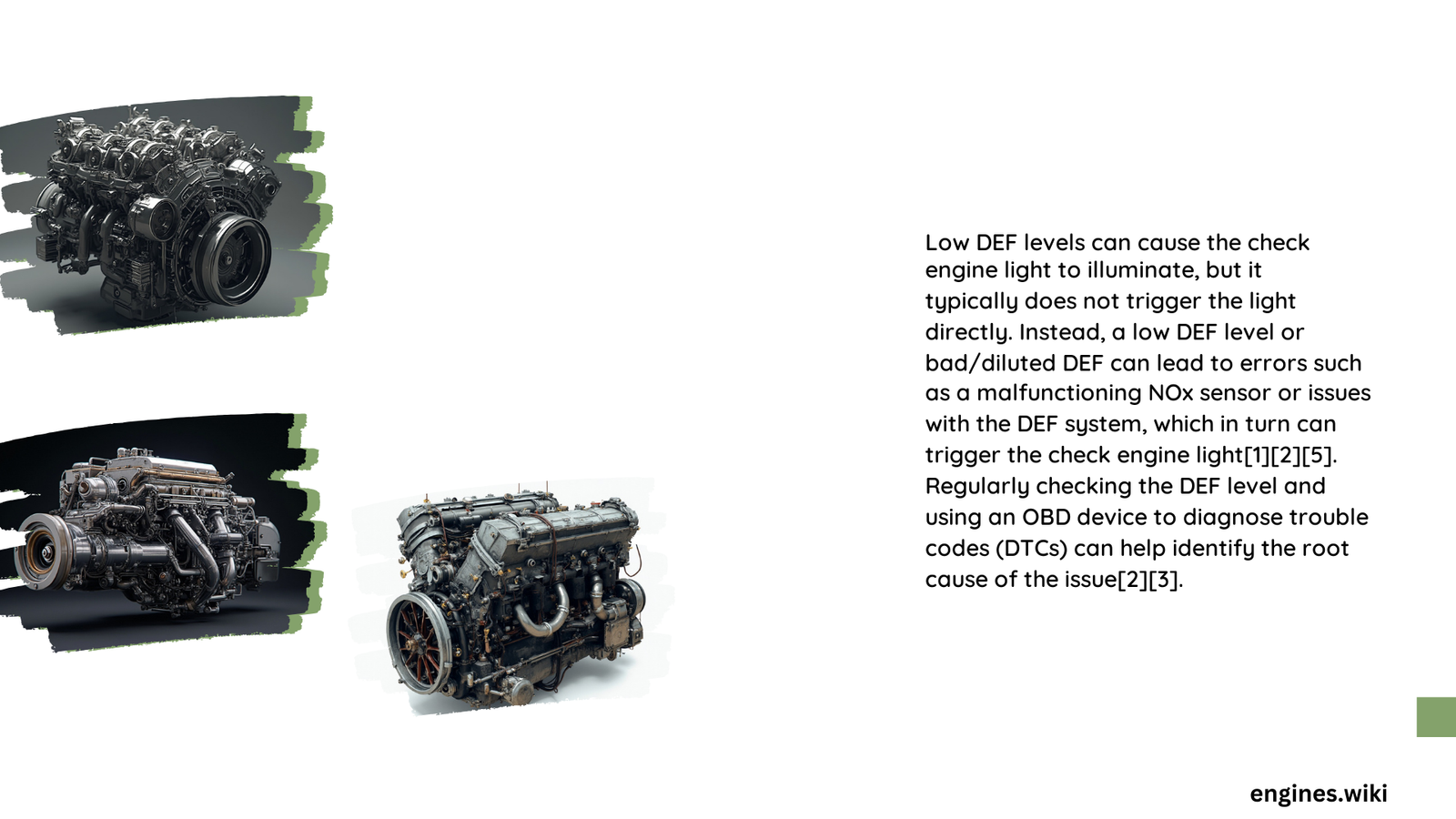Vehicle owners often encounter mysterious warning lights, and one critical concern is whether low Diesel Exhaust Fluid (DEF) can cause the check engine light to illuminate. Modern diesel engines rely on precise emission control systems, and DEF plays a crucial role in reducing harmful nitrogen oxide (NOx) emissions. When DEF levels drop critically low, your vehicle’s sophisticated onboard computer triggers warning indicators, potentially activating the check engine light as a protective measure to maintain environmental compliance and prevent potential engine damage.
What Triggers Check Engine Light with Low DEF?
Low DEF levels can indeed cause the check engine light to turn on, signaling potential issues within your vehicle’s emission control system. Here’s a comprehensive breakdown of how and why this occurs:
How Does Low DEF Affect Vehicle Performance?
When DEF levels become critically low, several performance-related consequences emerge:
- Warning Light Activation
- DEF level warning light illuminates
- Check engine light may appear
-
Potential error codes generated
-
Engine Performance Reduction
- Vehicle enters reduced power mode
- Speed limitations implemented
- Potential speed restrictions to 5-55 mph
What Diagnostic Trouble Codes Relate to Low DEF?
| Code | Description | Potential Action |
|---|---|---|
| P21B0 | Reductant Level Sensor Circuit High | Immediate DEF refill required |
| P20B8 | DEF Quality Below Threshold | System diagnostic needed |
| P20B9 | DEF Tank Level Sensor Circuit | Check DEF tank and sensors |
What Are the Specific Symptoms of Low DEF?
Vehicle owners should watch for these critical indicators:
- Illuminated check engine light
- Reduced engine power
- Potential speed limitations
- Dashboard warning messages
- Emission system performance alerts
How to Diagnose and Resolve Low DEF Issues?
Resolving low DEF problems requires systematic approach:
- Check DEF fluid levels immediately
- Use OBD-II scanner to read error codes
- Verify DEF fluid quality
- Refill DEF tank with manufacturer-recommended fluid
- Reset vehicle’s emission adaptation settings
What Are the Potential Consequences of Ignoring Low DEF?
Neglecting DEF levels can lead to:
- Increased harmful emissions
- Potential EPA non-compliance
- Significant engine performance degradation
- Expensive repair costs
- Possible vehicle immobilization
How Often Should DEF Be Checked?
Recommended maintenance practices:
- Check DEF levels during routine service
- Monitor dashboard indicators
- Refill before reaching critical low levels
- Use high-quality DEF fluid
- Follow manufacturer’s specific guidelines
What Is the Cost of DEF-Related Repairs?
Repair costs can vary significantly:
- DEF fluid refill: $10-$50
- Sensor replacement: $100-$300
- Comprehensive emission system repair: $500-$2,000
Technical Insights for Vehicle Owners
Modern diesel engines incorporate sophisticated emission control technologies. The selective catalytic reduction (SCR) system relies on DEF to convert harmful NOx emissions into harmless nitrogen and water. When DEF levels drop, this critical conversion process becomes compromised, triggering protective measures like reduced engine performance.
Professional Recommendations
- Always use high-quality DEF
- Maintain regular vehicle maintenance
- Address warning lights promptly
- Keep detailed service records
- Consult professional technicians for complex issues
Pro Tip: DEF has a limited shelf life and can degrade. Store in cool, dry conditions and use within recommended timeframe.
Reference:
– SAE International Diesel Emission Control Guidelines
– EPA Diesel Emission Regulations
– Bosch Automotive Emission Control Documentation

